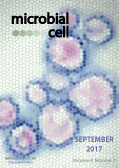Table of contents
Volume 4, Issue 9, pp. 278 - 310, September 2017
Cover: The image comprises a GFP-NCR1 fusion (here pink) in
S. cerevisiae to highlight the limiting membrane of the vacuole together with other stains highlighting the perimeter of the cell (cell wall or plasma membrane) and other organelles (image by Stephen L. Sturley, Columbia University Medical Center, NY, USA); image modified by MIC. The cover is published under the Creative Commons Attribution (CC BY) license.
Enlarge issue cover
Exacerbating and reversing lysosomal storage diseases: from yeast to humans
Tamayanthi Rajakumar, Andrew B. Munkacsi and Stephen L. Sturley
Reviews |
page 278-293 | 10.15698/mic2017.09.588 | Full text | PDF |
Abstract
Lysosomal storage diseases (LSDs) arise from monogenic deficiencies in lysosomal proteins and pathways and are characterized by a tissue-wide accumulation of a vast variety of macromolecules, normally specific to each genetic lesion. Strategies for treatment of LSDs commonly depend on reduction of the offending metabolite(s) by substrate depletion or enzyme replacement. However, at least 44 of the ~50 LSDs are currently recalcitrant to intervention. Murine models have provided significant insights into our understanding of many LSD mechanisms; however, these systems do not readily permit phenotypic screening of compound libraries, or the establishment of genetic or gene-environment interaction networks. Many of the genes causing LSDs are evolutionarily conserved, thus facilitating the application of models system to provide additional insight into LSDs. Here, we review the utility of yeast models of 3 LSDs: Batten disease, cystinosis, and Niemann-Pick type C disease. We will focus on the translation of research from yeast models into human patients suffering from these LSDs. We will also discuss the use of yeast models to investigate the penetrance of LSDs, such as Niemann-Pick type C disease, into more prevalent syndromes including viral infection and obesity.
Farnesol inhibits translation to limit growth and filamentation in C. albicans and S. cerevisiae
Nkechi E. Egbe, Tawni O. Dornelles, Caroline M. Paget, Lydia M. Castelli and Mark P. Ashe
Research Articles |
page 294-304 | 10.15698/mic2017.09.589 | Full text | PDF |
Abstract
Candida albicans is a polymorphic yeast where the capacity to switch between yeast and filamentous growth is critical for pathogenicity. Farnesol is a quorum-sensing sesquiterpene alcohol that, via regulation of specific signalling and transcription components, inhibits filamentous growth in C. albicans. Here we show that farnesol also inhibits translation at the initiation step in both C. albicans and S. cerevisiae. In contrast to fusel alcohols, that target the eukaryotic initiation factor 2B (eIF2B), farnesol affects the interaction of the mRNA with the small ribosomal subunit leading to reduced levels of the 48S preinitiation ribosomal complex in S. cerevisiae. Therefore, farnesol targets a different step in the translation pathway than fusel alcohols to elicit a completely opposite physiological outcome by negating filamentous growth.
A yeast model for the mechanism of the Epstein-Barr virus immune evasion identifies a new therapeutic target to interfere with the virus stealthiness
María José Lista, Rodrigo Prado Martins, Gaelle Angrand, Alicia Quillévéré, Chrysoula Daskalogianni, Cécile Voisset, Marie-Paule Teulade-Fichou, Robin Fåhraeus and Marc Blondel
Microreviews |
page 305-307 | 10.15698/mic2017.09.590 | Full text | PDF |
Abstract
The oncogenic Epstein-Barr virus (EBV) evades the immune system but has an Achilles heel: its genome maintenance protein EBNA1. Indeed, EBNA1 is essential for viral genome replication and maintenance but also highly antigenic. Hence, EBV evolved a system in which the glycine-alanine repeat (GAr) of EBNA1 limits the translation of its own mRNA at a minimal level to ensure its essential function thereby, at the same time, minimizing immune recognition. Defining intervention points where to interfere with EBNA1 immune evasion is an important step to trigger an immune response against EBV-carrying cancers. Thanks to a yeast-based assay that recapitulates all the aspects of EBNA1 self-limitation of expression, a recent study by Lista et al. [Nature Communications (2017) 7, 435-444] has uncovered the role of the host cell nucleolin (NCL) in this process via a direct interaction of this protein with G-quadruplexes (G4) formed in GAr-encoding sequence of EBNA1 mRNA. In addition, the G4 ligand PhenDC3 prevents NCL binding on EBNA1 mRNA and reverses GAr-mediated repression of translation and antigen presentation. This shows that the NCL-EBNA1 mRNA interaction is a relevant therapeutic target to unveil EBV-carrying cancers to the immune system and that the yeast model can be successfully used for uncovering drugs and host factors that interfere with EBV stealthiness.
Live fast, die fast principle in a single cell of fission yeast
Hidenori Nakaoka
Microreviews |
page 308-310 | 10.15698/mic2017.09.591 | Full text | PDF |
Abstract
Growth and death are both fundamental macroscopic properties for all living matters, and thus cell division and mortality rates are good parameters for characterizing cellular physiology in a given environment. While population growth rates in various conditions have been reported in literature, death rate is rarely measured, especially in favorable culture conditions where cells grow exponentially. In our recent study (Nakaoka and Wakamoto, 2017), we developed a microfluidics-based platform to track multiple single cell lineages until death. The system enabled us to monitor both cell growth and death in controlled steady environments, and we confirmed the absence of replicative aging in fission yeast old-pole cell lineages by showing remarkable constancy both in cell division and mortality rates. Furthermore, we revealed a growth-death trade-off relation in non-stressed conditions. The phenomenological law that constrains macroscopic physiological parameters could provide a new quantitative insight into possible balanced-growth states in various environments.










